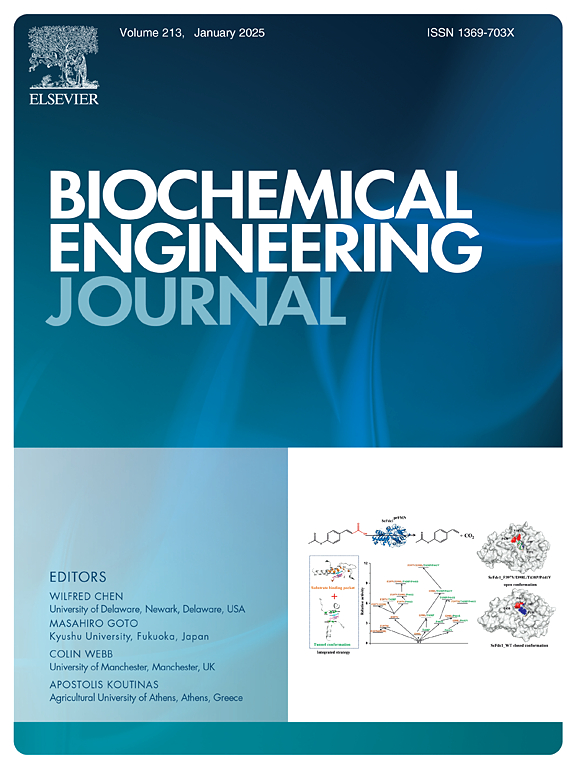肠杆菌 CS01 对 β-HCH 的降解:特性、机理及在土壤修复中的应用
IF 3.7
3区 生物学
Q2 BIOTECHNOLOGY & APPLIED MICROBIOLOGY
引用次数: 0
摘要
β-六氯环己烷(β-HCH)是一种对生态环境构成重大威胁的持久性有机氯农药,迫切需要开发有效的降解方法。微生物降解因其环保和经济的特点,在各种生物修复技术中显示出巨大的潜力。本研究评价了Enterobacter sp. CS01对β-HCH的降解能力、生理反应及其在土壤修复中的潜在应用。在最佳条件下(pH 7,30°C), β-HCH的有效去除率为51% %。代谢组学和抗氧化酶活性分析表明,CS01通过调节超氧化物歧化酶(SOD)和过氧化氢酶(CAT)的活性,包括丁酸、丙氨酸、天冬氨酸和谷氨酸代谢,以及戊糖磷酸途径,来防御氧化损伤。CS01通过二氯化物消除、氢的脱卤和水解反应将β-HCH转化为毒性较小的中间体。土壤试验表明,土壤酶活性(S-POD、S-DHA、S-PPO)与β-HCH的降解密切相关,利用碳源的顺序为酯类、氨基酸类、糖类。本研究为有机氯农药微生物降解机理的研究提供了新的思路,有助于开发更高效、更环保的降解技术。本文章由计算机程序翻译,如有差异,请以英文原文为准。
Degradation of β-HCH by Enterobacter sp. CS01: Characteristics, mechanism and application in soil remediation
β-Hexachlorocyclohexane (β-HCH) is a persistent organochlorine pesticide that poses a significant threat to the ecological environment, necessitating the urgent development of effective degradation methods. Microbial degradation has demonstrated substantial potential among various bioremediation techniques due to its environmentally friendly and economical characteristics. This study evaluates the degradation capability of Enterobacter sp. CS01 on β-HCH, its physiological responses, and its potential application in soil remediation. Under optimal conditions (pH 7, 30°C), 51 % of β-HCH was effectively removed. Metabolomics and antioxidant enzyme activity analyses revealed that CS01 defends against oxidative damage by modulating the activities of superoxide dismutase (SOD) and catalase (CAT), involving butyrate, alanine, aspartate, and glutamate metabolism, as well as the pentose phosphate pathway. CS01 converts β-HCH into less toxic intermediates through dichloride elimination, dehalogenation of hydrogen, and hydrolysis reactions. Soil experiments indicated that soil enzyme activities (S-POD, S-DHA, S-PPO) are closely related to the degradation of β-HCH, with the order of carbon source utilization being esters, amino acids, and sugars. This study provides new insights into the microbial degradation mechanisms of organochlorine pesticides and aids in the development of more efficient and environmentally friendly degradation technologies.
求助全文
通过发布文献求助,成功后即可免费获取论文全文。
去求助
来源期刊

Biochemical Engineering Journal
工程技术-工程:化工
CiteScore
7.10
自引率
5.10%
发文量
380
审稿时长
34 days
期刊介绍:
The Biochemical Engineering Journal aims to promote progress in the crucial chemical engineering aspects of the development of biological processes associated with everything from raw materials preparation to product recovery relevant to industries as diverse as medical/healthcare, industrial biotechnology, and environmental biotechnology.
The Journal welcomes full length original research papers, short communications, and review papers* in the following research fields:
Biocatalysis (enzyme or microbial) and biotransformations, including immobilized biocatalyst preparation and kinetics
Biosensors and Biodevices including biofabrication and novel fuel cell development
Bioseparations including scale-up and protein refolding/renaturation
Environmental Bioengineering including bioconversion, bioremediation, and microbial fuel cells
Bioreactor Systems including characterization, optimization and scale-up
Bioresources and Biorefinery Engineering including biomass conversion, biofuels, bioenergy, and optimization
Industrial Biotechnology including specialty chemicals, platform chemicals and neutraceuticals
Biomaterials and Tissue Engineering including bioartificial organs, cell encapsulation, and controlled release
Cell Culture Engineering (plant, animal or insect cells) including viral vectors, monoclonal antibodies, recombinant proteins, vaccines, and secondary metabolites
Cell Therapies and Stem Cells including pluripotent, mesenchymal and hematopoietic stem cells; immunotherapies; tissue-specific differentiation; and cryopreservation
Metabolic Engineering, Systems and Synthetic Biology including OMICS, bioinformatics, in silico biology, and metabolic flux analysis
Protein Engineering including enzyme engineering and directed evolution.
 求助内容:
求助内容: 应助结果提醒方式:
应助结果提醒方式:


